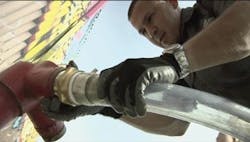About the author:
Justin Price is managing director of Hydro(Gen) Innovations Inc. Price can be reached at [email protected] or 562.686.9313.
In order to combat increasing storm water pollution, commercial buildings and other occupancies with fire sprinkler systems are experiencing sweeping changes when testing their sprinkler equipment.
Federal, state and local laws require regular testing of fire sprinkler systems to ensure correct operation in the event of a fire. Governed by NFPA 25 guidelines, maintenance checks are required every five years or sooner by the authorities having jurisdiction. Due to the five-year dormancy, the water becomes stagnant and contaminated with harmful pollutants, including heavy metals, chemicals, disease-causing agents, oils, nitrates, hydrocarbons, minerals and anaerobic bacteria.
When the system is discharged, typically to open surfaces and into storm drains, it violates the federal Clean Water Act (CWA) and National Pollutant Discharge Elimination System (NPDES). The annual estimated number of gallons discharged into storm drains and waterways in North America is almost 33.6 billion, which is the equivalent of 51 million Olympic-sized swimming pools.
Because of the significance of the problem, on July 1, 2009, the California Regional Water Quality Control Board – San Diego Region 9 revised its area water-use disposal laws to treat fire sprinkler maintenance activities as “illicit discharges.” Since then, others have followed suit or are in the process of doing so, as noncompliance is not worth the financial risk.
Searching for a Solution
Traditional best management practices (BMPs) for controlling sprinkler discharge meant sand bags or hay bales around storm drains to filter out larger particles or the diversion of water-to-tank trucks for offsite treatment and disposal. Sand bags and hay bales are limited in efficiency and remove only particles such as silt. Water tank trucks cost up to $1 per gallon, adding thousands to maintenance costs.
These methods were some of the only options available until a new invention from Los Angeles-based Hydro(Gen) Innovations Inc. caught the attention of fire authorities, California regional water boards and an increasing number of fire prevention contractors and facilities maintenance engineers. For the past four years, Robert M. Sanchez, president of Hydro(Gen) Innovations, had been working on a portable filtration system to incorporate control at the point of discharge.
| Filters can be used to control sprinkler discharge. |
“As a California licensed fire protection contractor with over 25 years experience in the fire sprinkler industry, I was concerned about the stench and color of fire sprinkler water which my employees had to endure,” Sanchez said. “But, like many Californians, I realized this discharge was polluting our oceans, streams, rivers and valuable natural water resources.”
In 2006, Sanchez searched for a solution to comply with the federal CWA, NPDES and local ordinance regulations. The NFPA 25 standard testing procedures require that four mandatory tests be performed when servicing fire sprinkler equipment: a simulation of a fire sprinkler head activation (inspector’s test), a main drain test to witness a pressure drop and re-pressurization, flushing the entire system for external inspection of the alarm check valve, and a fire department connection “backflush test."
Sanchez realized that for the solution to work for everyone, it had to be delivered at the point of discharge and would require a filtration process prior to discharging to the storm drains or open surfaces. Filtration, however, could not compromise the testing process by causing flow restriction.
“The challenge to come up with a viable solution to this problem was clear,” Sanchez said. “We had to make the system compact, easy to use, affordable for all contractors and facilities maintenance personnel, and it had to be very effective.”
Crystal-Clear Results
The prototype latched onto a building’s external sprinkler connection allowed polluted water to flush through the unit. With a three-phase filtration system, the now-trademarked EcoSmart filter used a strainer basket, then a low-micron filter bag and finally a bacteria- and hydrocarbon-removing polymer media.
| Tests confirm this three-phase filtration system’s effectiveness. |
“The result was astonishing,” Sanchez said. “I remember comparing the pre- and post-filtrated samples. I couldn’t believe it: There was no smell at all. The water before was very dirty, now it was crystal-clear.”
After months of changes and re-testing, independent laboratory tests confirmed that the results were significantly below the U.S. Environmental Protection Agency’s maximum containment level. External engineering expertise was brought in, refining the initial prototype to ensure that the new filter met the rigorous demands of varying industries.
“My industry now has no excuses not to adopt effective BMPs,” Sanchez said. “The EcoSmart filter meets my initial objectives: It’s affordable, easy to use, portable and will protect our valuable water resources.”


